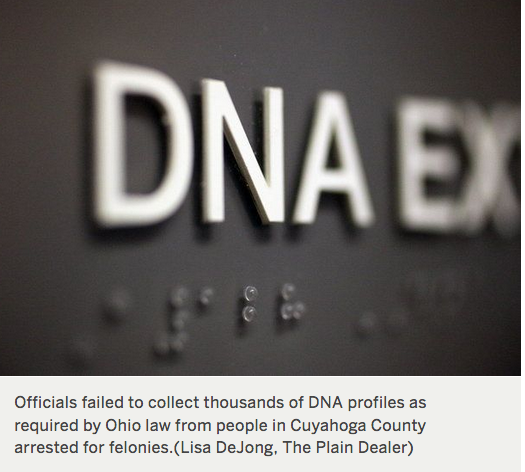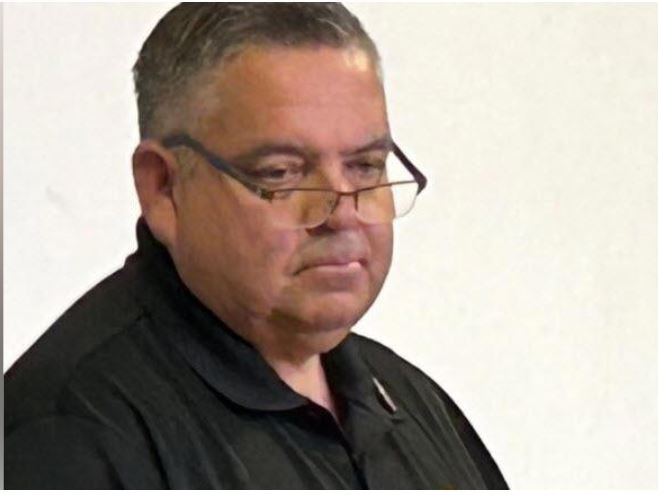DNA from thousands of Cuyahoga County felony arrests never taken, not in CODIS crime-solving database
Officials now are trying to determine how many DNA profiles police or
courts failed to collect as required by state law. It could be as many
as 10,000.
June 16, 2017
CLEVELAND, Ohio - DNA samples from thousands of people arrested or charged with felonies in Cuyahoga County since mid-2011 were never collected, or were not properly collected, and are not in the state database used to solve crimes, state records show.
Officials now are trying to determine how many DNA profiles police or courts failed to collect as required by state law. It could be as many as 10,000.
The county prosecutor's office is also leading an effort, along with law enforcement agencies, courts and a research team to obtain the "owed" DNA and close the collection gaps, which in the past have allowed people to elude arrest for serious crimes such as rape and murder.
What we know comes from two lists compiled by the Ohio Bureau of Criminal Investigation (BCI), which oversees the state's libraries of DNA profiles collected during arrests or after convictions for felonies and certain misdemeanors, or gathered from crime scenes and rape evidence kits. The state's databases are connected to the federal Combined DNA Index System, or CODIS.
Ohio's law, which requires the swabs be collected at arrest, rather than conviction, took effect on July 1, 2011. From that time until Jan. 1, 2017, BCI found:
- 10,003 people arrested for felonies in Cleveland did not have DNA profiles in the system.
- 8,338 people arrested or booked by the Cuyahoga County Sheriff's office not have DNA profiles in the system.
No duplicate arrests are on the individual lists. However, there might be overlap between the Cleveland police department list and the Cuyahoga County Sheriff's office list, Jill DelGreco, a spokeswoman for Attorney General Mike DeWine said. Officials consider the lists preliminary because they contain felony arrests made under state, not local, codes and also include arrests for crimes like domestic violence, which can be either a felony or a misdemeanor. State officials said arrests for misdemeanors qualifying for collection, including some sex crimes, are not included on the lists. Cleveland Chief Calvin Williams has assigned a committee to look where gaps in the department's policy may be, spokeswoman Jennifer Ciaccia said in an email. Some of the missing profiles, she said, could include people later charged with felonies after an initial arrest for an offense like drunk driving. Officers would not have collected DNA during the booking process in those cases, she said. Missing and 'owed' DNA Last year, the prosecutor's office and Case Western Reserve University's Begun Center received a $1 million, three-year federal grant - the first of its kind in the country - to analyze the scope of the problem and figure out how, if possible, to collect the DNA owed by the felony arrestees
They applied for the grant after a task force working to investigate cases associated with untested rape kits encountered several cases where a rapists DNA should have been in the system but wasn't.
DNA collection should happen during the booking process, just like fingerprinting, Rick Bell, the prosecutor's office Chief of Special Investigations said today during testimony today on Capitol Hill before a Congressional Bipartisan Task Force to End Sexual Violence. If collected, it can be matched to DNA from rape kits, murder scenes or burglaries, he said.
Also testifying at the hearing of the task force, co-chaired by Ohio Rep. Dave Joyce, of Bainbridge Twp., was Law & Order SVU actress and founder of The Joyful Heart Foundation Mariska Hargitay. She produced of the documentary film "I Am Evidence," which features Cleveland's efforts to investigate more than 6,000 cases stemming from previously untested sexual assault evidence kits. The film is expected to air on HBO this winter or in the spring, Hargitay said.
Ken Mills, Cuyahoga County director of Regional Corrections, said when he learned of the issue last week during a meeting with the prosecutor's office and court officials, he was dumbfounded because the county's policy is clear: Each person booked into the jail each year should be swabbed for DNA if their profile wasn't previously collected.
Mills said he soon realized that proper procedures were in place but quality assurance and accountability was lacking, made harder by the fact that jail takes in more than 26,000 arrestees from more than 50 suburbs as well as those booked for court charges.
"That's where the lapse is," he said. "The problem is that you don't know right away if it has been done somewhere else."
Knowing how valuable the profiles can be to solving crimes, Mills said the jail now will collect the profile, even if it ends up being a duplicate. It will also check twice that the swab has been collected: when an inmate is booked in and when they are being released.
County Prosecutor Michael O'Malley, who also testified in Washington Friday, instituted a new policy on May 30 that requires assistant prosecutors to check whether the DNA of defendants with felonies or certain misdemeanor crimes had been collected and are in Ohio's DNA data bank. If it wasn't, the policy outlines eight separate times during the court process from arraignments to probation violation hearings that prosecutors can ask a judge to order the swab be collected or notify the court it is not in the system.
"When this issue was brought to my attention, I contacted the Sheriff's Office and the Court so that we can work collaboratively to obtain DNA from all individuals required under the law," O'Malley said this week.
Ohio's law allows DNA to be collected at arrest for felonies and certain misdemeanors but also at any time while a person is in jail, in a community corrections facility or on probation or parole.
The law also specifies that courts "shall inquire" at the time a person is sentenced if the DNA has been collected and, if not, order it taken within 24 hours.
DNA collection is built into the courts sentencing process and the probation department is also supposed to check that a sample has been collected, a court spokesman said.
Common Pleas Administrative Judge John J. Russo said this week that the court is looking at how it can "potentially help with the DNA collection process."
Past failures known
There are no repercussions for police departments or courts that don't follow the law.
The failure by law enforcement and prison officials to collect the cell-laden swabs has come up in a number of cases in recent years reported on by The Plain Dealer, including two serial rapists who also murdered women - Anthony Sowell and Larry McGowan.
Sowell's DNA was supposed to be collected and put into CODIS while he served a prison stint for attempted rape. It wasn't until after he was arrested for the murders 11 women in 2009 and rapes of several others.
McGowan admitted in April to raping six women and to raping and killing Maxine Pratt in 1997. Police hunted for him for more than a decade, knocking on doors and putting a sketch of him on a billboard. McGowan has numerous arrests and was in and out of prison but it wasn't until Akron police arrested him for a rape there in 2012 that his DNA was put into CODIS, leading to his arrest and conviction for the other violent crimes.
Cuyahoga County's Sexual Assault Kit Task Force also has identified 'John Does" or unidentified serial rapists through new DNA collected from men who should have been swabbed during earlier arrests.
Of 122 John Doe indictments in Cuyahoga County, Bell said at least eight unknown rapists have been identified after felony arrest DNA was collected. (Cuyahoga County has indicted nearly 600 defendants based on testing of rape kits since 2013.)
After the Sowell and McGowan cases, BCI worked to shore up the collection process in prisons and created a way for local law enforcement agencies search to see if DNA profiles from their arrests made it into the state databank of arrest and conviction profiles, Del Greco said. Agencies also can create a report through the Ohio Law Enforcement Gateway (OHLEG) of DNA profiles not collected or not properly collected.
DNA problems elsewhere
The DNA collection problem isn't unique to Cleveland or Cuyahoga County, though it might be larger here because of the high number of felony arrests -- between 6,000 and 10,000 in recent years -- and past policies in Cleveland that didn't require that arrestees be forced to provide the DNA.
Athens County authorities last month said a 26-year-old man now charged with raping three college-aged women over a decade, would have been identified earlier if his DNA had properly been collected in 2015 when the Ohio State Patrol arrested him for driving drunk and a firearms charge, according to The Athens News.
Shawn Lawson Jr., is also charged raping another woman in March. His DNA collected in that case was linked to the earlier rapes.
Authorities in Omaha, Nebraska, this week also connected a man whose DNA wasn't collected at conviction, as required under that state's law, to the serial rapes of four children, according to The Omaha World-Herald.
Streamlining the procedures could be made easier by the Cuyahoga County's takeover of Cleveland's jail operations. Under an agreement approved June 13, the county will take over responsibility for the booking and collection of DNA swabs from Cleveland those arrested and charged in Cleveland who qualify.
Mills said the continuing regionalization of the county's jail system would make it easier to ensure all of the DNA profiles are accounted for.
"You would have one source in the county doing this all," he said.
UPDATED: This story was updated at 6:17 p.m. with comments from Cleveland police spokeswoman Jennifer Ciaccia.



